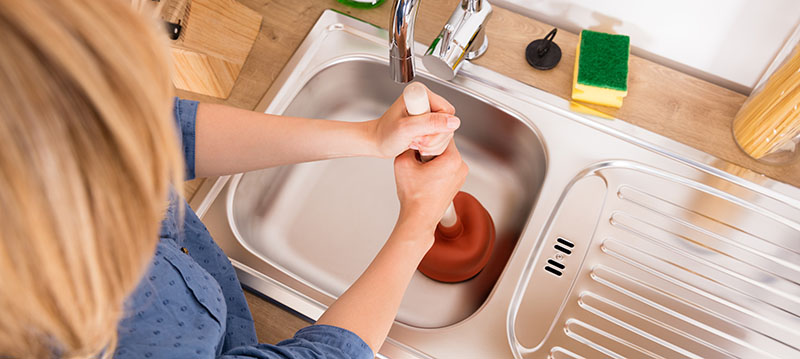Here below you can find a bunch of very good resources all about Why Is My Sink Not Draining?.

It's not normal for your kitchen area sink to block several times in one month. If your sink blocks two times a week, there's some trouble taking place.
A blocked cooking area drainpipe doesn't simply slow down your jobs, it deteriorates your entire plumbing system, gradually. Right here are some common routines that encourage sink obstructions, and exactly how to avoid them.
You require proper garbage disposal
Recycling waste is excellent, but do you focus on your natural waste too? Your kitchen area should have 2 separate waste boxes; one for recyclable plastics as well as an additional for organic waste, which can come to be compost.
Having actually a designated trash bag will certainly assist you and also your family prevent throwing pasta as well as various other food remnants down the tubes. Typically, these remnants soak up moisture as well as come to be clogs.
The mistake isn't from your kitchen area sink in all
Maybe the issue isn't from your cooking area sink, but the whole drain system. In such an instance, you may discover that sinks and drains obtain obstructed every other week. You need an expert plumbing solution to repair this.
You're throwing coffee down the tubes
Utilized coffee premises and coffee beans still take in a substantial quantity of moisture. They may appear little enough to throw down the drain, however as time takes place they start to swell and take up more area.
Your coffee premises should go into organic garbage disposal. Whatever portion runs away (perhaps while you're washing up) will be looked after during your regular monthly clean-up.
You have actually been consuming a great deal of greasy foods
Your kitchen sink may still get obstructed despite natural garbage disposal. This might be because you have a diet rich in greasy foods like cheeseburgers.
This grease layers the within pipelines, making them narrower and also more clog-prone.
Use a plunger
Your pipeline had not been dealt with effectively to begin with
If you have actually been doing none of the above, however still obtain routine blockages in your kitchen sink, you ought to call a plumber. There might be a problem with just how your pipelines were set up.
While your plumber shows up, check for any leaks or abnormalities around your kitchen area pipes. Do not attempt to fix the pipelines on your own. This may create a crash or a kitchen area flooding.
Somebody tried to clean their hair in the kitchen sink
There's a correct time as well as place for every little thing. The kitchen area sink is just not the appropriate location to wash your hair. Cleaning your hair in the kitchen area sink will make it block sooner or later unless you make use of a drainpipe catcher.
While a drain catcher could catch a lot of the after effects, some strands might still get through. If you have thick hair, this might be enough to reduce your drain and ultimately form an obstruction.
There's more dust than your pipes can take care of
If you get fruits straight from a farm, you might discover even more kitchen area dust than other people that go shopping from a shopping center. You can conveniently fix this by cleansing the fruits as well as veggies correctly prior to bringing them right into the house.You require proper garbage disposal
My Kitchen Sink Won’t Drain - What Should I Do?
If Your Sink Has a Garbage Disposal...
Turn on the disposal. If the disposal hums and doesn’t turn, then there’s clog in the disposal unit. Go to your circuit breaker panel, and switch off the circuit breaker to your garbage disposal. Back in your kitchen, double-check that your garbage disposal is off by trying to turn it on. The disposal should not move, and it should not make any noise. Lie down underneath your sink so that you can see and access the bottom of the disposal unit. Look for a hole that looks like the head of a hex-head bolt in the center of the unit. Place an Allen wrench inside this hole and turn it from side to side until you feel a decrease in resistance and are able to rotate the wrench completely in a single direction. This action rotates your disposal’s blade manually. Put the wrench aside, and press the disposal unit’s reset button or switch. Flip your garbage disposal’s circuit breaker switch back on, and turn on the unit to see if the obstruction has cleared. If it hasn’t, repeat the steps above until the obstruction is removed. How to Unclog a Kitchen Sink Drain
If you have a double bowl sink, seal one side of the sink with an airtight lid or a second plunger before plunging the other side. Otherwise, you won’t be able to create adequate suction. Place the cup of the plunger completely over the drain opening. Turn on the faucet, and let the water run until it completely covers the cup of the plunger. Start plunging by pushing the plunger down and pulling up again in order to build up suction. Make sure that the edges of the plunger stay in contact with your sink, or else you’ll lose the suction. If you have trouble forming a seal between your sink and plunger, add petroleum jelly to the mouth of your plunger, and try again. Plunge about five or six times before removing the plunger to see if water starts to drain properly. In some cases, you’ll even be able to feel the clog become dislodged while you plunge because suddenly there will be much less resistance. Repeat the plunging process until the clog clears. Once water is draining properly again, run hot water down the drain for 5 minutes to help clear away grease, grime, and debris from the clog. https://www.plumbingjoint.com/blog/2019/august/my-kitchen-sink-won-t-drain-what-should-i-do-/

I ran across that blog post about Why Is My Sink Not Draining? when doing research the web. So long as you appreciated our blog entry if you please remember to pass it around. Thanks a lot for your time invested reading it.
Contact Us Now
 Luke Perry Then & Now!
Luke Perry Then & Now! Christina Ricci Then & Now!
Christina Ricci Then & Now! Elisabeth Shue Then & Now!
Elisabeth Shue Then & Now! Karyn Parsons Then & Now!
Karyn Parsons Then & Now! Susan Dey Then & Now!
Susan Dey Then & Now!